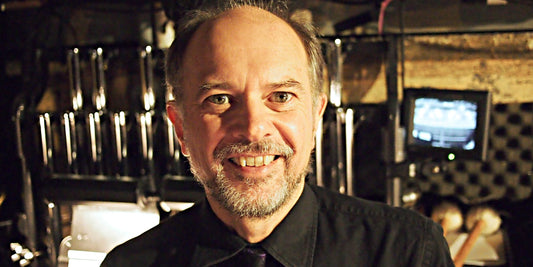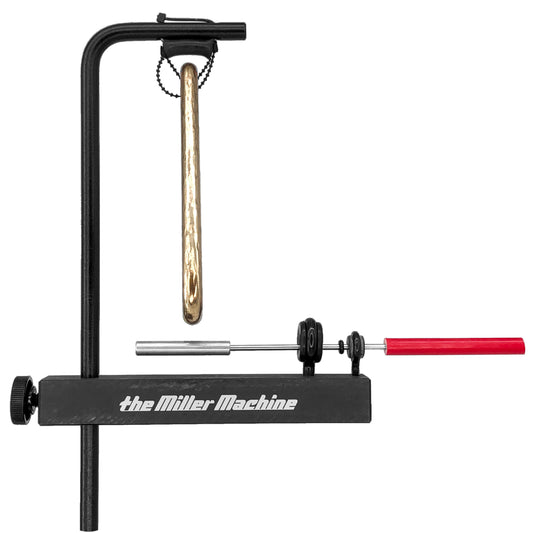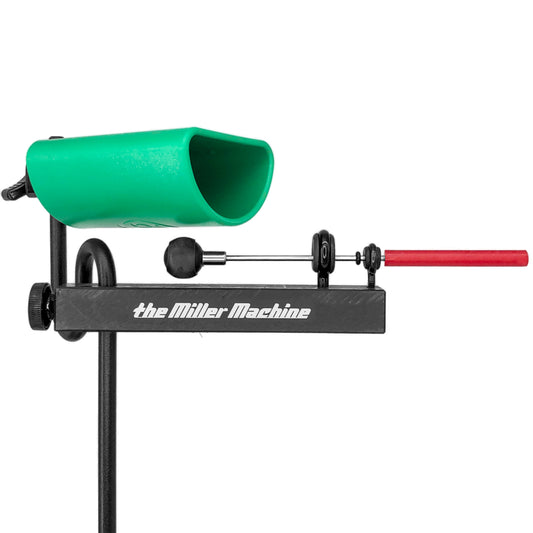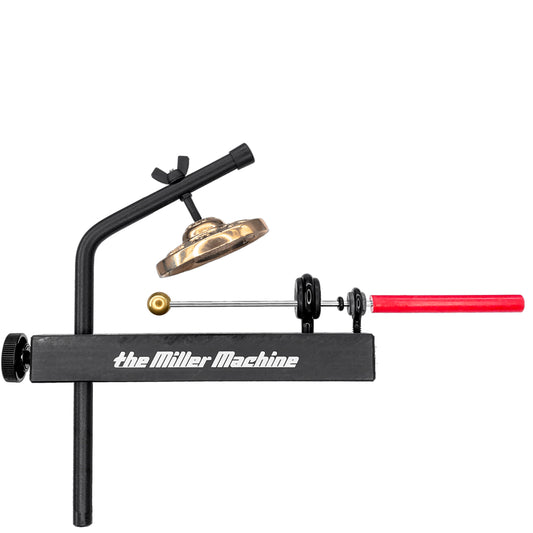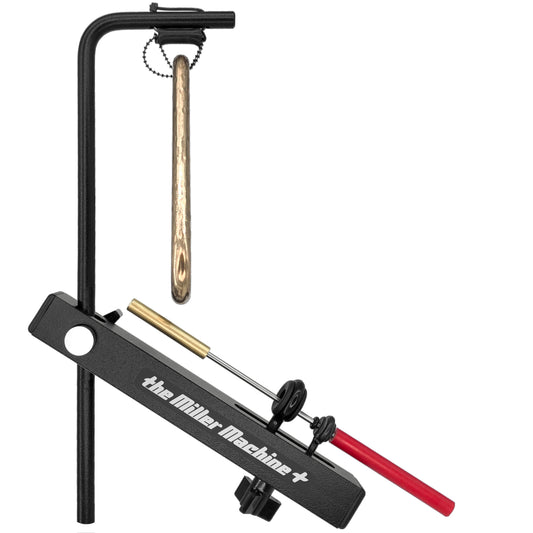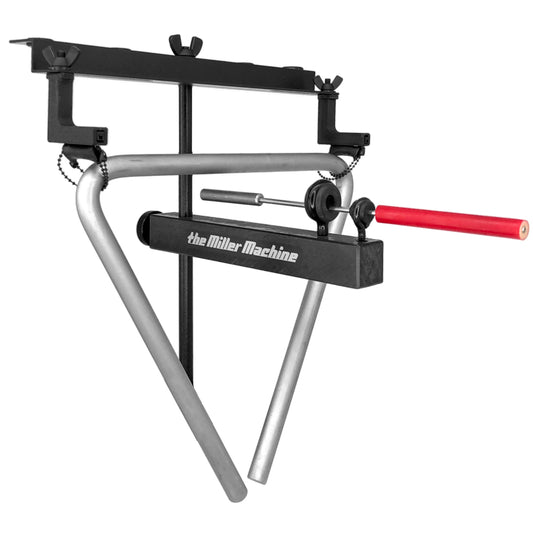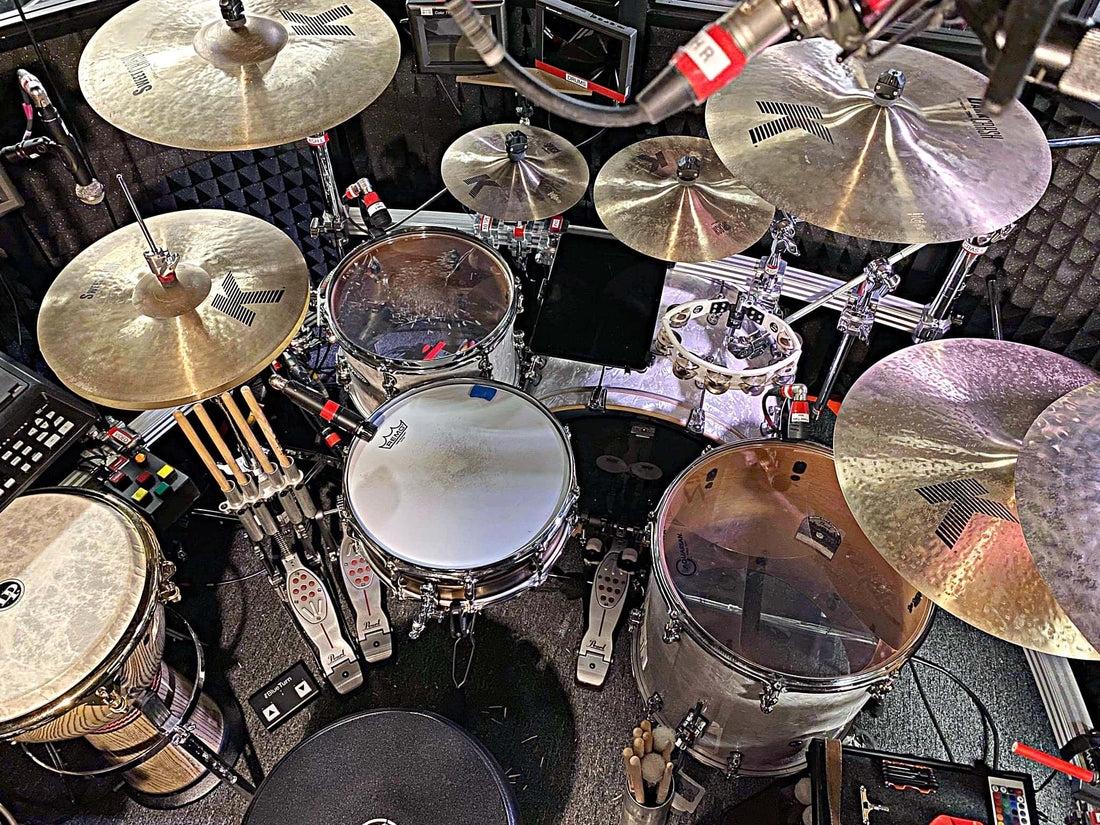
Frozen - Jeff MacPherson
Jeff MacPherson's setup for the National Tour of Disney's Frozen.
Write-up and gear list below photos.




















Jeff:
"Don’t tell anyone I said this, but the drum set book on Frozen is not about drums. It’s about QLab. That is not to diminish the importance of the drums in the show. To the contrary, the drums are integral to not only the orchestrations, but to the overall production as well. At times, the drums drive the band as they drive the show. Sometimes it’s by way of simple rock grooves bolstered and necessitated by unbridled conviction and belief. Other times the drums add color and nuance to a melodic, yet portentous orchestral passage. But in whatever capacity they’re functioning, they’re never boring. The drum book is challenging. It’s rewarding when you get it right. And it’s dynamic. One minute you might be playing a carefully orchestrated and delicate philharmonic snare drum part in 7|8, and the next, like the final chorus of 'Let It Go', you’re beating the hell out of the drums in straight up 4|4 like there’s no tomorrow. But as essential as it may be, the truth is, the drum set is secondary to QLab.
On Frozen, we use QLab software to run audio files, lighting effects, and video segments. Although there are many talented people from every department on this tour who work extremely hard, I don’t know if we could do this show without QLab. For better or for worse, QLab has become integral to the performance of our show. It does a lot. It’s very powerful. And fortunately for those of us who rely on it, it’s bulletproof.
All QLab cues are synced to a click track which is triggered from a Roland SPD-SX sampling pad operated by yours truly. The sampling pad is also loaded with percussion sounds.
I did not program the QLab cues or the Roland sampling pad. That was done by someone in New York much smarter than me. I have no business doing anything like programming. In fact, my lack of skill in this department reminds me of something Neil Peart once purportedly said, 'I just hit things with sticks for a living.' Yeah, Neil. Me too.
Although I make a living striking things, I would not call myself a percussionist. I’m just a guy who plays the drums and happens to whack some extra things along the way. I see it like this: If I happen to hit whatever percussive item I’m supposed to hit at the right time and it makes the right sound and no one gets mad at me, then I figure I’ve done my job well. But to call me a percussionist is generous at best and misleading at worst. True percussionists bring a sense of artistry to striking a wide array of varied instruments and in the process of doing so make beautiful music. Me, I’m just a drummer. I still make beautiful music, but with a smaller palette.
As a self-declared percussionist-impostor, I have only one thing to say about my percussion setup: The Miller Machine is brilliant. I mean it. It’s a thoughtful, clever, simple, well designed, and indispensable item for any drummer/percussionist. In fact, it’s so well designed it makes me wonder if Billy Miller when he set out to develop his eponymous machine sat down and read Dieter Rams’s* Ten Principles of Good Design first. Indeed, Billy’s creation hits on all of Rams’s ideas about design and exploits them to the fullest. I have used this ingenious device for a decade and it’s never let me down. Like QLab, it too is bulletproof. On Frozen I use two Miller Machines. One for the finger cymbal and one for the triangle. I couldn’t play the show without the Miller Machines. That’s the truth.
I like to set up my drums low and flat. And there are two reasons for this. Power and visibility.
First, power. I like to hit hard. And I’ve found that having a drum placed low and flat allows me to strike it harder with greater ease. This positioning applies equally to all of my drums, but perhaps most critically to the snare drum. A low and flat snare drum increases my chances of hitting the drum deliberately and consistently every time for that all-important backbeat. The same applies to hi-hats and crash cymbals and the bell of the ride cymbal. I like to hit them on the edge with the shoulder of the stick for a bigger, fuller sound. And if I need to play quietly, this low and flat positioning of the instrument allows for lighter dynamic applications too.
I sit behind my drums at a low to medium height. My hips are parallel to the floor. This allows me to generate as much power as possible when hitting the bass drum. To me, a solid and committed striking of the bass drum is as equally important as a strong backbeat, maybe even more important. Drums, and in particular, the bass drum, are a foundational element in just about any given musical situation in which drums are used. So it’s important they’re played with conviction. That doesn’t necessarily mean loudly. Just deliberately. And my setup is designed around the idea of maximizing this principle to its fullest.
Second, visibility. The truth is, conductors and band members like to be able to see the drummer. I’m not certain why that is. But I think it has to do with the energy a drummer can bring to the music. Drums are a dynamic and physical instrument. And a drummer, just by the nature of their instrument, is able to readily apply power and energy to whatever music they’re playing — perhaps more readily than any other instrument. The visual component and effect of this power and energy cannot be overstated.
I also think conductors feel better — reassured, if you will — knowing their drummer is there, present with them. Conductors don’t like it if they feel you’re trying to hide from them, even if you’re not. Let’s face it, a drummer/conductor relationship is a symbiotic one whose essence comes down to working together as harmoniously as possible to produce a desired musical result. I think a good drummer/conductor relationship has a healthy amount of push and pull. And visibility is often (though not always) a critical element in developing a good give and take relationship which results in, hopefully, a good performance. Visibility is just another form of communication. And communication is always good — whether it’s by listening to, or watching, each other.
I play Pearl Drums’ Reference Pure Series drums. I’ve been with Pearl since I was 14 years old and I made it official when I became a Pearl artist about five years ago. I choose to play Pearl’s RFP drums because of their shells. Comprised of thin plys of maple and African mahogany woods, the RFP drums offer more resonance in the low end frequency range. This results in a deeper tone with a longer decay. And because the shells are thinner than most other drums in Pearl’s line up, the lighter mass shell is able to more effectively produce a resonant, smooth, and warm tone. And these are the characteristics I look for when choosing a drum.
In helping to produce a drum with more resonance, the RFP drums use minimal mass, vintage-style lug casings which look cool, but more importantly, limit shell contact and aid in freeing up the drum to resonate as openly as possible. Typically, the smaller drums in the RFP series are 6-ply (hi toms) and the larger drums are 8-ply (bass drums and floor toms). But each ply is thinner than Pearl’s standard shell configuration resulting in a thinner shell overall. However, because of the thinner shell, the RFP drums suffer, albeit subtly, from a lack of volume and projection when compared to a standard shell drum. But for me, the sonic properties (tone, decay, color, etc.) inherent in the thin shell more than make up for any perceived lack of volume. Besides, every musical situation in which I find myself these days requires my drums to be mic’ed. So volume and projection are never an issue.
I like bigger drums. I have a 20” gong drum at home with enough bottom end to shake the walls. And my go-to bass drum at home is a 26” x 18”. It will shake the walls, too. And the floor. And the ceiling. I had always wanted to try a 26” kick drum and I finally got the opportunity when I was on The Book Of Mormon tour a few years ago. I loved that drum then and I still do now. But the music of Frozen requires more conventionally sized drums. So I’m down to a 22” kick drum, a 13” tom, and a 16” floor tom. The 22, although it doesn’t have the same oomph as the 26, has a nice punch and throaty quality to it. I remember reading an interview with Neil Peart many years ago in which he described the quality he liked best in his closed 12” tom. He called it throaty. And that’s how I would describe the 22. Throaty. Yes, it’s a healthy, throaty baritone. I guess that means it sings. I like that.
I tune all of my drums (except for the snare drum) low. I like big, fat, resonant, warm sounding drums and I find that tuning the batter head of a drum a bit lower than the resonant head helps me achieve the sound I’m looking for. I shouldn’t admit this, but what the hell… I sometimes have my bass drum batter head so loose it will actually start rotating to the left or right after I’ve played a few shows. Then I have to go back and straighten it up and tighten down the tension rods a bit more just to keep it in place. I know. I know. But it sounds so good that way. Plus, I can lean into it without the beater snapping back or fluttering against the head. To help in the prevention of what I call ‘beater bounce’, I use rounded felt beaters on my bass drum pedals. And for a little extra attack and longevity, I always use the Impact Patch that comes standard with a Remo P3 Powerstroke bass drum head. For dampening, I use a Pearl bass drum muffler inside the kick drum. It’s pressed up against the batter head and does not touch the resonant head. I have a 5.25” port cut into the bass drum’s resonant head to accommodate a microphone. And the microphone of choice these days is a Shure Beta 52A. We also mic the bass drum from the outside. For this we use a sub-woofer style microphone placed about an inch and a half away from the resonant head. This mic, which looks like a small speaker, is designed to capture low end frequencies. I like my bass drum to have a lot of snap and a lot of bottom end. No mids. And with this dual mic setup I get plenty of both. I also use a butt kicker mounted to the underside of my seat for the added illusion of bottom end.
The tom and floor tom are wide open with no dampening. They and the philharmonic snare drum and the bottom of the djembe are all mic’ed with Sennheiser e 604s.
The main snare drum has a reliable old workhorse Shure SM57 on top and a Sennheiser MD441-U on the bottom. Because my snare drum is brass and tuned high it has a nice crack and ring to it. But sometimes the ring is a little too much so I use a moon gel placed at the edge of the top head for a little dampening.
The hi-hats are mic’ed with a Beyer Dynamic M160. Overhead mics are Mojave MA-50s. The Mojaves are big and rectangular and black with a silver screen over the pickup area and the body is mounted in some type of spring loaded cage system. They’re all very high tech and expensive looking — and I’m sure they are. We also use a room mic to capture the overall sound of the drum set. The room mic is a very expensive Royer R-122. Don’t tell anyone, but it costs almost as much as the drums themselves. Crazy, right?
I like to add a little bit of reverb to my drums to give them some air and some space and some presence in my headphone mix. And if you add reverb properly, you won’t even know it’s there until you take it away. That’s the trick with reverb.
I use Pearl hardware. Everything except the mic stands is mounted on a drum rack. We don’t mount the mic stands on the rack because of the potential for the microphones to pick up unwanted vibration. The drum rack allows for the convenient placement of all the voices within the drum set and it has the added bonus of taking up less ever-so-valuable floor space. This is crucial since the drums are set up within an isolation booth where space is often at a premium. The drum rack, along with the stands, is light, strong, dependable, versatile, intuitive, and aesthetically pleasing. What more could you want?
Typically, I like smaller and thinner cymbals that speak quickly. But Frozen requires a different sonic palette in the upper frequencies. So I’m playing 19” crashes, 15” hi-hats, larger splash cymbals, and a 22” ride. Except for the China cymbal and an ice bell, all cymbals are from Avedis Zildjian’s K line. I find the Ks are warmer and mellower than the As. They’re darker and have less shimmer and less sparkle but these are the qualities I appreciate and prefer to hear in a cymbal. Ks are what I use at home, too. I’ve been playing Zildjian cymbals since I was 13 years old. And I still love them as much today as I did back then.
The latest bit of technology I’ve incorporated into my setup is an iPad Pro. The iPad is running forScore software — essentially sheet music in digital form. I have the iPad placed low and flat (not so I can hit it hard, but so I can easily see it) right above my bass drum so it sits directly in front of me. When I first started using the 26” kick drum I found I had to move my rack tom further to the left as the 26” drum was too large to have the tom placed low and flat above it. I quickly got used to this setup and rather liked the way it felt. So I kept it even when I used a smaller bass drum. The empty space above the kick drum has now provided a very convenient spot in which to mount the iPad. No more music stands. No more page turns (a foot switch does the work now). No more stand lights. No more craning my neck to the left to read the music. No more clutter. I love it.
As for my other gear, well, I have a bicycle out here on the road. It’s a 2021 Canyon Aeroad CF SLX 8 Disc AXS and it’s black on black. It looks badass. It has a carbon fibre frame and SRAM Force eTap AXS Groupset componentry and the whole thing weighs just 7.73 kg. I ride as much as I can. I’ve tackled Mt. Evans, CO; Mt. Lemmon, AZ; Mt. Tamalpais, CA; Mt. Baldy, CA; Little Cottonwood Canyon, UT and many other mountains and flatlands throughout the United States, Canada, Mexico, and France. I also ride to and from the show as much as possible. I love my bike."
"Okay, I could write an entire book about my bike and my adventures but that’s not what this website is about. Here’s the detailed drum specs:"
Drums: Pearl - Music City Custom in Reference Pure Spec with a White Marine Pearl finish
- 22” x 14” Bass Drum
- 13” x 4” Philharmonic 8-ply Maple Snare Drum
- 13” x 9” Tom
- 16” x 16” Floor Tom
- 14” x 5” Sensitone Premium Beaded Brass Snare Drum (Main)
- 14” x 6.5” Sensitone Premium Beaded Brass Snare Drum (Backup)
Hardware: Pearl (unless noted otherwise)
- DR-513C Icon Drum Rack
- P2052C Eliminator Redline Double Bass Drum Pedal
- H2050 Eliminator Redline Hi-Hat Stand
- S1030 Snare Drum Stand (x2)
- CH1030B Boom Cymbal Holder (x7)
- CH1030BS Boom Cymbal Holder (x4)
- UX80 Clamp
- DCA180 Clamp (x2)
- D3500 Drum Throne
- PTT8511 Tech Tray
- Meinl Djembe Stand
Cymbals: Zildjian A & K
- 22” K Custom Dark Ride
- 19” K Dark Thin Crash (x2)
- 15” K Sweet Hi-Hats
- 10” K Splash
- 12” K Splash
- 19” A Zildjian Ultra Hammered China
- 9.5” Large Zil Bel
Percussion
- LP 12.5” Galaxy Giovanni Series Djembe
- TreeWorks 35-Bar Classic Single-Row Mark Tree
- LP Cyclops Mounted Tambourine (Steel)
- Black Swamp Percussion Woodblock (x2, Hi and Lo)
- Miller Machine (Brass Beater) with Finger Cymbal
- Miller Machine (Brass Beater) with Grover TR-6 6” Super Overtone Triangle
- LP 229 Mambo Cowbell
- Meinl 16” Siam Oak Frame Drum
Drumsticks and Hitting Things: Vic Firth
- American Classic 1A w/Wood Tip
- CT1 - Corpsmaster Timpani Mallets
- Jazz Brushes
Drum Heads: Remo
Bass Drum:
- P3 Powerstroke Clear w/ Impact Patch (x2) (Batter)
- P3 Powerstroke Coated w/ 5.25” Port (Resonant)
- Pearl BDMF Bass Drum Muffler
Snare Drum:
- Coated Ambassador X (Batter)
- Clear Ambassador Snare Side (Resonant)
Philharmonic Snare Drum:
- Ambassador Renaissance (Batter)
- Ambassador Renaissance Snare Side (Resonant)
Tom & Floor Tom:
- Clear Emperor (Batter)
- Clear Ambassador (Resonant)
Electronics
- QLab Software
- Roland SPD-SX Sampling Pad
- iPad Pro w/forScore Software
- iRig Blue Turn Foot Switch
- Aviom A360 Mixer
- Ultimate Ears UE-11 In-Ear Monitors
- Butt Kicker Amplifier and Transducer
- Konig & Meyer Tablet/iPad Holder
Microphones
Bass Drum:
- Shure Beta 52A (Inside)
- Solomon LoFreq Sub (Outside)
Snare Drum:
- Shure SM57 (Top)
- Sennheiser MD441-U (Bottom)
Tom & Floor Tom:
- Sennheiser e 604
Philharmonic Snare Drum:
- Sennheiser e 604
Hi-Hats:
- Beyer Dynamic M160
Overheads:
- Mojave MA-50
Djembe:
- Sennheiser MKH 8040 (Top)
- Sennheiser e 604 (Bottom)
Percussion: (incl. Triangle, Finger Cymbal, Woodblocks, Cowbell)
- Neumann KM 140
Room Mic:
- Royer R-122
Where to Find Me
- Facebook: Jeff MacPherson
- Instagram: jeffmacpherson.drums
- Website: https://jeffmacpherson.tumblr.com
- Pearl Drums: https://pearldrum.com/artist/jeff-macpherson
- Zildjian Cymbals: https://zildjian.com/jeff-macpherson.html
*"If you don’t know who Dieter Rams is, look him up. His ideas concerning good design and the products he’s designed are pretty cool."
https://readymag.com/shuffle/dieter-rams/ten-commandments/
Frozen - Tour - Jeff MacPherson
August 23, 2021 thru September 01, 2024



